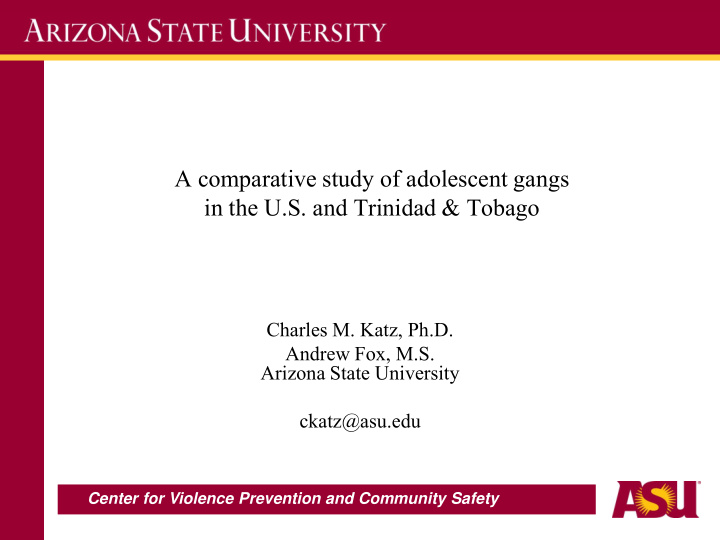



A comparative study of adolescent gangs in the U.S. and Trinidad & Tobago Charles M. Katz, Ph.D. Andrew Fox, M.S. Arizona State University ckatz@asu.edu Center for Violence Prevention and Community Safety
Gangs and violence in the Caribbean • Little research has examined gangs and/or violence in the Caribbean. • Anecdotal evidence suggests that these problems have grown significantly. • No research has examined the relationship between community coviates and their relationship with gangs and/or violence. • The Caribbean has little infrastructure to understand their gang and/or violence problems. Center for Violence Prevention and Community Safety
The present study Examines similarities and 1. The proportion of school youth differences among gang involved in gangs, members in Trinidad and 2. The age individuals join a gang Tobago and one jurisdiction in and the reasons they join a gang, the United States (Arizona) to 3. Differences between gang and understand the prevalence, non-gang members in terms of nature, and seriousness of the their experiences with gang problem in one developing delinquency, drug use, and and one developed nation. victimization. 4. Difference in risk and protective factors for joining a gang. Center for Violence Prevention and Community Safety
About T&T… • Population 1.3 million • East Indian 40.0%, African 37.5%, Afro-Indian 20.5% • Roman Catholic 26.0%; Hindu 22.5%; Protestant 24.6%; Islam 5.8%; Shouter Baptist 5.4%; other Christian 10.7% • Parliamentary democracy with two major political parties (PNM and UNC) • Granted independence on August 31, 1962 • Major industry is petroleum (40% of GDP)
Homicides by Weapon Type: 1988-2008 500 450 400 350 300 250 200 150 100 50 0 1988 1989 1990 1991 1992 1993 1994 1995 1996 1997 1998 1999 2000 2001 2002 2003 2004 2005 2006 2007 2008 Firearms Sharp Instruments Blunt Other
Data 1. Trinidad & Tobago Youth Survey • Adapted from the Social Development Research Group, Communities that Care and the Arizona Youth Survey • Surveyed approximately 2,300 students, Forms 4 thru 6. • 22 of 27 urban schools participated. 2. Arizona Youth Survey • Adapted from the Social Development Research Group & Communities that Care. • Administered to 8 th , 10 th , and 12 graders (we restricted sample to 8 th and 10 th grades) • Randomly selected within each county by school size, & school type. We restricted to urban schools. • Final sample includes 136 schools and 21,317 students. Center for Violence Prevention and Community Safety
Some of the complexities of cross-national research • Common instrument • Common sampling frame • Common instrument administration • Common data cleaning and entry / • Common analysis Center for Violence Prevention and Community Safety
Demographic characteristics USA Trinidad & Tobago • 7.6% members • 12.5% members • About 40% of gang • About 40% of gang members are female. members are female • Gm’s are more likely to • Gm’s are older than non - be: gang members. – Black • Gm’s in TT are older than – Hispanic USA – Other • No sig. difference between ethnic groups Center for Violence Prevention and Community Safety
Gang characteristics and reasons for joining USA Trinidad & Tobago • 90% have a name • Two-thirds have a name • Gm’s in US have more gm • Gm’s in TT become friends involved in a gang later in life (about 6 months later) • More likely to join for: • More likely to join for – Protection friendship – Other reasons Center for Violence Prevention and Community Safety
Self-reported delinquency and victimization • Gm’s in both nation’s more likely to be involved in delinquency, drug use, & victimization • Levels of violence similar across nations • More involvement in property crime overall among US sample, but gang/non-gang-ratio is similar to TT • More involvement in drug sales overall among US sample, but gang/non-gang-ratio is greater in TT • Ratio for arrest is greater in the USA Center for Violence Prevention and Community Safety
Self-reported delinquency and victimization, Cont. • More alcohol use overall among TT sample, but gang/non-gang-ratio is greater in USA • More marijuana use overall among USA sample, but gang/non-gang-ratio is greater in TT • Level of victimization similar across USA and TT Center for Violence Prevention and Community Safety
Risk factors associated with gang joining • Community disorganization (USA) • Perceived availability of handguns (TT) • Academic failure (USA) • Intention to use drugs (TT) • Perceived risk of drug use (TT) • Anti-social peers (USA) • Sensation seeking (TT) Center for Violence Prevention and Community Safety
Protective factors for gang joining • Social skills (TT) Center for Violence Prevention and Community Safety
Accumulation of risk and protective factors • In both nations, the greater the # of risk factors the greater the likelihood of gang joining. – However, even those who report being at risk for 17 or more factors are not always reporting gang membership (less than 40% in both nations) • In both nations, the greater the # of protective factors the less likely the respondent reports joining a gang. • Center for Violence Prevention and Community Safety
Conclusions There are some differences There are many similarities between nations: between nations: – Female membership – Prevalence of gang membership – Gm’s are more involved in delinquency and drug use – Magnitude of difference between – Magnitude of difference between gm’s and non - gm’s did not vary gm’s and non - gm’s did vary for for violence & victimization property crime, drug use, etc. – Risk & protective factors for – Reasons for joining gang membership – Gang characteristics and age of involvement Center for Violence Prevention and Community Safety
Recommend
More recommend